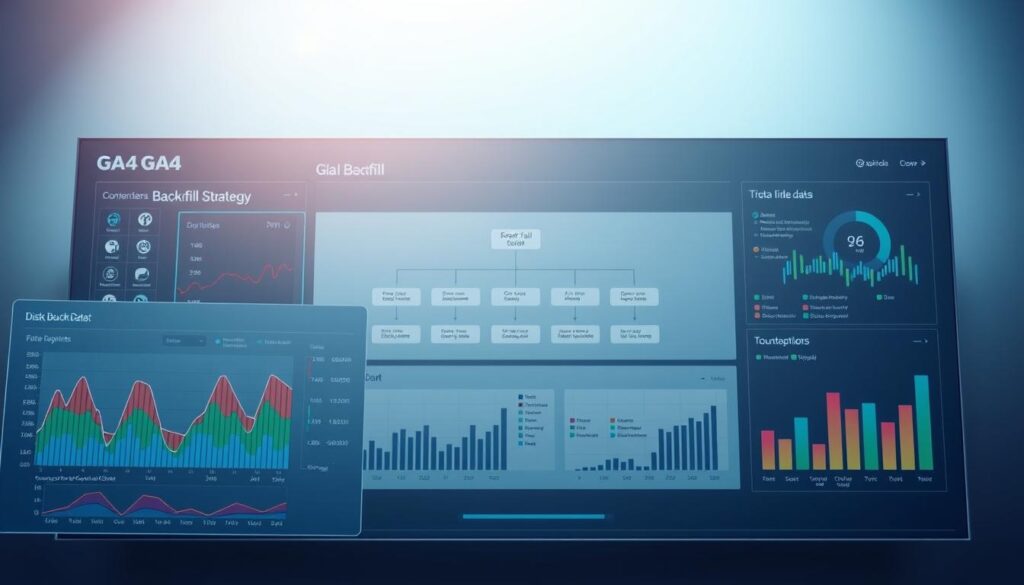Did you know up to 35% of key website events can be missed in Google Analytics 4? This is because of setup mistakes. It shows how urgent it is to have a plan for GA4 backfill to get back lost event data.
As someone who works with digital analytics, I know how vital it is to track all data. The GA4 backfill process helps businesses get back event data that was missed early on.
Tracking events in Google Analytics 4 can be tricky. It often leads to missing data. This missing data can mess up how we understand user behavior and marketing success.
Learning how to backfill GA4 events is key. It helps keep your data complete and accurate. This is important for making smart decisions based on real digital data.
Key Takeaways
- Up to 35% of website events can be untracked in GA4
- GA4 backfill helps recover missing critical event data
- Comprehensive event tracking is key for accurate analytics
- Data gaps can lead to wrong understanding of user behavior
- Keeping tracking up to date stops data loss in the future
Understanding GA4 and Its Importance
Digital analytics has changed a lot with Google Analytics 4 (GA4). It now helps businesses track user interactions better. GA4 gives deep insights into how users behave and what they do.
Today’s digital marketing needs strong analytics tools. GA4 is a powerful tool that helps track user journeys well. It also helps find and fix missing data in GA4.
What is Google Analytics 4?
GA4 is a big step up from Universal Analytics. It focuses on tracking events, not just page views. This lets businesses see more detailed user actions on websites and apps.
Key Features of GA4
| Feature | Description |
|---|---|
| Cross-Platform Tracking | Unified data collection across web and mobile platforms |
| Machine Learning Insights | Predictive analytics and automated trend identification |
| Enhanced Event Tracking | Detailed user interaction monitoring |
Why Accurate Event Data Matters
Getting accurate event data is key to knowing user behavior. Incomplete or missing events can lead to big mistakes. This can make businesses think they’re doing better than they really are.
“Data integrity is the foundation of meaningful analytics.” – Digital Marketing Expert
By using strong tracking, companies can collect all the data they need. This helps them make better decisions and plan their strategies.
Common Reasons for Missing Events
Tracking events in Google Analytics 4 can be tough. Knowing why data is missing is key for good analytics. I’ve found a few main reasons why events don’t get tracked right.
![]()
Tracking Configuration Issues
Setting up tracking wrong can lead to missing events in GA4. Bad tracking codes can miss important user actions. Issues include wrong event parameters, data streams, and tag management.
| Configuration Problem | Potential Impact |
|---|---|
| Incorrect Tracking Code | 0-100% Event Loss |
| Misconfigured Data Streams | 30-50% Data Reduction |
| Wrong Tag Management | 20-40% Event Tracking Failure |
Data Sampling Challenges
GA4 uses smart sampling that can hide data. When there are fewer than 50 users or events, Google might not show all traffic. This makes it hard to track everything and needs careful watching and analysis.
User Consent and Privacy Regulations
Privacy laws like GDPR and CCPA affect data collection a lot. Users can choose not to be tracked, which can miss some data. It’s important to get clear consent and respect users’ choices to keep data and laws in line.
Understanding these challenges is the first step to complete GA4 event tracking.
How to Identify Missing Events in GA4
Finding missing events in GA4 can be tough for digital marketers and analysts. It needs a smart plan and a close look at how data is tracked. GA4 event data recovery is key for keeping analytics accurate.
To spot missing events, you must check various tools in the Google Analytics 4 platform. Experts use many methods to catch all data and avoid missing anything important.
Using the DebugView for Insights
The DebugView tool gives detailed views of how events are tracked. I suggest looking closely at event streams in real-time to find missing events in GA4. This tool lets you see right away if events are being tracked correctly, helping find any issues fast.
Analyzing Real-Time Reports
Real-time reports show what’s happening now with user actions. By comparing what should be happening and what is, you can find missing events and other tracking problems. Checking both expected and actual events helps find where data might be missing.
Conducting Event Audits
Event audits are thorough checks of how tracking is set up, custom event details, and paths to conversions. I recommend making a detailed checklist for audits. This helps make sure all important user actions are tracked, keeping your analytics insights complete.
Keeping a close eye on things and checking regularly is essential for solid GA4 event tracking. It helps avoid any breaks in data collection.
Techniques for Backfilling Missing Events
Recovering lost event data in Google Analytics 4 needs careful planning. It’s important to use reliable methods to backfill GA4 events well.
Knowing the right techniques for Google Analytics 4 event backfill is key. Each method has its own benefits for rebuilding your digital tracking.
Utilizing Measurement Protocol
The Measurement Protocol is a strong server-side tool for sending historical events to GA4. It lets me send events that were missed before. But, it needs precise timestamps and correct event details.
Importing Historical Data
Importing old data needs careful setup. CSV files or exported data can be turned into GA4 event streams. Using templates that fit GA4’s event schema helps avoid mistakes.
Leveraging BigQuery for Data Recovery
BigQuery is a top tool for detailed event recovery. It connects raw data sources and uses complex queries to find and fix missing events. This method is great for complex tracking needs.
Steps to Implement GA4 Backfill
Getting missing event data back in Google Analytics 4 needs a smart plan. Developers and analysts can use steps to get all data back. This makes sure you have everything you need.
Filling in missing GA4 events takes many important steps. You need to be precise and know your stuff. Planning and doing it right is key.
Preparing Measurement Protocol Configuration
Start by setting up Measurement Protocol well. You’ll need a unique client ID and secure API keys. Make sure your setup fits with your GA4 property settings for smooth data flow.
| Configuration Step | Required Action |
|---|---|
| Client ID Generation | Create unique identifier matching GA4 standards |
| API Credentials | Generate secure authentication tokens |
| Data Mapping | Align event parameters precisely |
Data Formatting Strategies
Formatting data right is key for missing GA4 events. Standardize event names and keep parameter structures the same. Also, check data types before sending it.
Validation and Testing Procedures
Testing is vital to check your backfill plan works. Use GA4’s DebugView to see if events are sent and if data is correct. Test different scenarios to find any issues before you start for real.
By following these steps, you can automate GA4 event retrieval. This helps bring back important insights for analysis.
Best Practices for Event Tracking in GA4
Getting data right in Google Analytics 4 needs careful planning and detailed work. Good event tracking helps avoid losing data and keeps your tracking up to date.
![]()
Good event tracking means you get all the data you need. I’ll show you how to make your GA4 tracking better.
Consistent Naming Conventions
It’s key to have a clear naming system for events. Make a simple, easy-to-understand system. This keeps your data clean and easy to track.
Utilizing Custom Dimensions and Metrics
Custom dimensions and metrics give you more insight. They let you track specific things that regular tracking might miss. This way, you don’t lose important data.
| Custom Dimension Type | Tracking Purpose | Potential Insights |
|---|---|---|
| User-Level | Capture persistent user attributes | Demographic information, loyalty status |
| Event-Level | Track specific interaction details | Product categories, engagement types |
| Session-Level | Analyze session-specific data | Traffic sources, device information |
Regularly Reviewing Tracking Implementation
It’s important to check your GA4 tracking often. Do this every three months to make sure everything is working right. This helps keep your data accurate and complete.
By using these tips, you’ll make sure your event tracking is strong. This means you won’t lose data and will get useful insights for your online plans.
Analyzing the Impact of Backfilled Data
After fixing GA4 event data, it’s key to see how it changes your digital marketing plans. Looking at the backfilled data gives you deep insights into user actions and habits.
Getting back missing events in GA4 lets you see your digital world more clearly. It shows you performance metrics you might have missed because of tracking gaps.
Comparing Pre- and Post-Backfill Metrics
Comparing data before and after fixing it shows big differences. Looking at key performance indicators before and after helps you see where and how tracking was off.
Understanding User Behavior Changes
With recovered event data, you get a new view of how users move through your site. Some actions that seemed random now look more planned. This gives you better insights into what users want and how they engage.
Making Informed Decisions Based on Data
GA4 event data recovery turns raw data into useful information. By adding in missing events, you can make smarter choices about user experience, marketing, and product development.
Data is only valuable when it’s complete and accurate.
Your recovered GA4 events are more than just old data. They’re key assets that can change how you do digital analytics.
Resources for Continuous Learning and Improvement
Keeping up with Google Analytics 4 event backfill needs constant learning. Digital marketing experts can use many sources to improve their GA4 skills. This helps them stay sharp in analytics.
The official Google Analytics documentation is the best place to learn about GA4. Google offers detailed guides and tutorials. These help users understand event tracking and data recovery.
Online learning sites have courses and webinars for Google Analytics 4. Sites like Coursera, LinkedIn Learning, and Google’s training offer structured learning. They cover everything from basic setup to advanced data recovery.
Community forums and support groups are key for growth. Places like the Google Analytics Community Forums, Reddit’s analytics subreddits, and LinkedIn groups are great. They let experts share knowledge, solve problems, and keep up with new GA4 updates.



